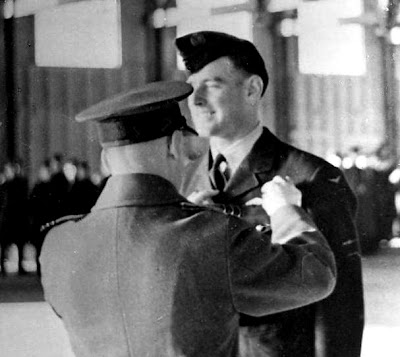AW2 Laura Bagby moving Cessna Crane with a tractor September 3, 1942.
Saturday, February 2, 2013
Squadron Leader Raymond Edward Thorold-Smith, DFC
Photo - Wing Commander Arthur Dwight Ross, officer commanding No. 3 SFTS, Calgary, pins wings on the tunic of Leading Aircraftman Raymond Edward Thorold-Smith, January 16, 1941.(RCAF photo)
Raymond Edward Thorold-Smith
No. 3 Service Flying Training School, Currie Barracks, Calgary October 28, 1940. Graduated January 16, 1941.
57 Operational Training Unit February 12 - April 21, 1941
No. 452 Squadron, Royal Australian Air Force, was the first Australian squadron to form in Britain during the Second World War in accordance with Article XV of the Empire Air Training Scheme. Its first personnel took up their posts at Kirton in Lindsey on 8 April 1941 and, flying Supermarine Spitfires, the squadron became operational on 22 May.
Pilot Officer Thorold-Smith led Yellow section on a target support sortie August 9, 1942. Red section was led by Squadron Leader Brendan Eamonn Fergus "Paddy" Finucane. Soon after reaching the French coast, a large number of Me.109's were encountered. The squadron claimed 5 enemy aircraft destroyed which included one shared Finucane shared with Thord-Smith. During a September 18 bomber escort to Rouen, Pilot Officer Thord-Smith destroyed a Me.109. He destroyed another October 13 during a Blenheim escort to Arques. Squadron Leader Finucane and Keith 'Bluey' Truscott each destroyed 3 - 109's.
Photo - November 1941 - 400213 Squadron Leader Keith 'Bluey' Truscott (left), Squadron Leader Brendan Eamonn Fergus "Paddy" Finucane RAF (centre) and 402144 Squadron Leader Raymond Edward Thorold-Smith of No 452 Squadron RAAF. (Credit - AWM)
On November 6, 1941, Thorold-Smith led "A" Flight escorting three Curtiss Tomahawks which were to attack coastal gun positions in France. Thord-Smith described the subsequent encounter with enemy aircraft in a combat report: "I was port leader Yellow 1 at 12,000 feet N.W. of Griz Nez and flying south, 6 enemy aircraft dived on rear of port section. I turned my section hard to port. I did a diving beam to quarter attack on rear enemy aircraft (Me.109F) from 300 yards to 200 yards with cannon and machine gun - saw flashes in front of cockpit and engine - no evasive action. Left enemy aircraft in steep dive leaving thin black smoke increasing rapidly. Felt something amiss, saw over left shoulder a radial engine aircraft doing fine port quarter attack from 50 yards. No warning from Yellow 2 - I assume that this enemy aircraft had shot him down. Still turning to port, I jammed back the stick, did very steep climbing turn and knew enemy aircraft couldn't follow - then throttled fully back, whipped into vertical turn in opposite direction. Below and to starboard I saw a Spitfire going down on its back pouring out white smoke from coolant radiator, then saw enemy aircraft again below, slightly ahead and crossing from port to starboard, I could still see a radial engine and standard camoflage. I did a diving starboard beam to quarter attack starting with about 4 lengths of deflection from 300 yards. Fired very short bursts and kept watch behind - closed to 200 yards. Pieces flew off cowling and tail unit, and thin black smoke came from enemy aircraft. At 8000 feet approximately, he dived vertically - I followed to 500 feet and watched him dive into the sea about 8 miles N.W. of Gris Nez."
Photo: Buckingham Palace - Squadron Leader R. E. Thorold-Smith of No. 452 (Spitfire) Squadron RAAF, shows his DFC to his fiancée, while 13009 Corporal Charles Marshall looks on. London Gazette December 2, 1941 - Distinguished Flying Cross Citation: "This officer has participated in 50 operational sorties since July, 1941. He has proved himself to be first class fighter pilot and a most determined and capable fighter leader. He has destroyed 5 enemy aircraft and shared in the destruction of another."
Subscribe to:
Post Comments (Atom)



No comments:
Post a Comment